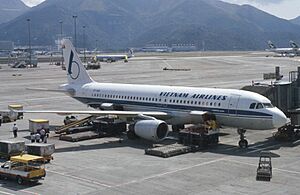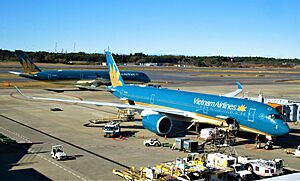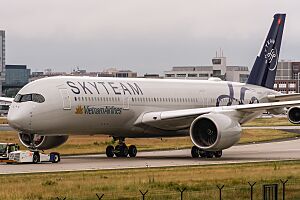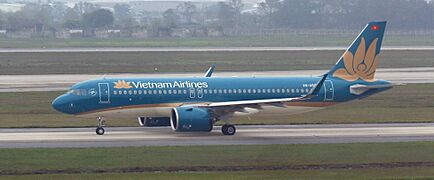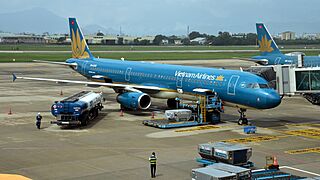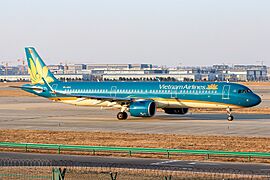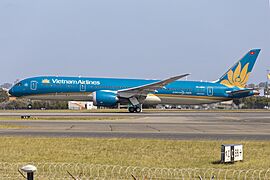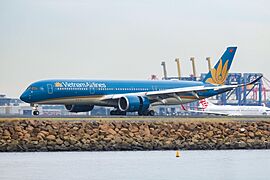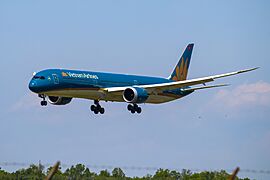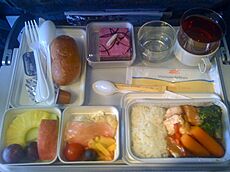Vietnam Airlines facts for kids
A Vietnam Airlines Boeing 787-9
|
|
| Founded | 15 January 1956 (as Vietnam Civil Aviation) |
|---|---|
| Hubs |
|
| Secondary hubs | |
| Focus cities |
|
| Frequent-flyer program | Lotusmiles |
| Alliance | |
| Subsidiaries |
|
| Fleet size | 96 |
| Destinations | 65 |
| Parent company | Vietnam Airlines JSC |
| Headquarters | 200 Nguyễn Sơn, Bồ Đề ward, Long Biên district, Hanoi, Vietnam |
| Key people | |
| Revenue | US$3.9 billion (2023) |
| Employees | 6,500 (2023) |
Vietnam Airlines is the main airline of Vietnam. It is often called the "flag carrier" because it represents the country. The airline started in 1956 and became a company owned by the government in 1989.
Its main offices are in Long Biên district, Hanoi. The airline has major hubs, which are like main bases, at Noi Bai International Airport in Hanoi and Tan Son Nhat International Airport in Ho Chi Minh City. Vietnam Airlines flies to 117 different places in 19 countries around the world.
For many years, until the early 1990s, Vietnam Airlines was a smaller airline. This was due to various challenges in Vietnam. When the United States and Vietnam improved their relationship, the airline was able to grow. It started offering better services and updated its older planes.
In 1996, the Vietnamese government created the Vietnam Airlines Corporation. The airline was the most important part of this new group. Later, in 2010, it became a limited company called Vietnam Airlines Company Limited. A special board chosen by the Vietnamese Prime Minister helps run the company.
Vietnam Airlines is very important for Vietnam's economy. It helps people travel and goods move around. The airline also owns other companies. For example, it fully owns Vietnam Air Service Company, which is a regional airline. It also owns almost all of Pacific Airlines, a low-cost airline. Besides flying, Vietnam Airlines also makes money from airplane food and fixing planes. It even invests in renting out planes and airport services.
In June 2010, Vietnam Airlines joined SkyTeam. This is a big group of airlines that work together. It was the first airline from Southeast Asia to join SkyTeam. As of September 2021, the Vietnamese government owns most of Vietnam Airlines (86.34%). A Japanese airline group, All Nippon Airways, owns a smaller part (5.62%).
Contents
History of Vietnam Airlines
How it All Began
Vietnam Airlines started in January 1956. Back then, it was called Vietnam Civil Aviation. The government of North Vietnam created it after taking over Gia Lam Airport. The airline was part of the Vietnam People's Air Force but flew for civilian purposes.
At first, its fleet included planes like the Lisunov Li-2s. These were later replaced by Ilyushin Il-14s and Aero Ae-45s. This was because an embargo made it hard for the airline to get American planes or parts.
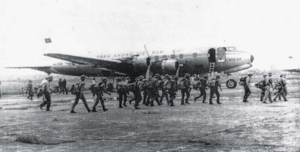
The Vietnam War (1955–1975) made it difficult for the airline to grow. After the war, Vietnam Airlines started flying to other countries. Its first international flight was to Beijing, followed by Vientiane in 1976. In 1978, flights to Bangkok were added. By the late 1980s and early 1990s, the airline flew to places like Hong Kong, Kuala Lumpur, Manila, and Singapore.
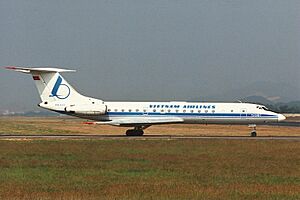
In 1990, the airline wanted to buy planes made in Western countries. However, they had to cancel plans to get two Airbus A310s. This was because these planes used engines made in the United States, and the embargo was still in place.
Later, Vietnam Airlines found ways to lease Western planes. They leased a Boeing 737-300 and an Airbus A310. By 1993, they also started using a Boeing 767-200ER and an Airbus A320-200. This allowed them to fly to new international cities like Paris, Tokyo, Seoul, Taipei, Sydney, and Melbourne.
Becoming a National Airline: 1993–2006
In 1993, Vietnam Airlines became the official "flag carrier" of Vietnam. This meant it was the country's main airline. It also became a state-owned company, separate from the Civil Aviation Administration of Vietnam. The military unit that operated the flights, the 919th Air Force Regiment, became the "Flight Crew Division 919." This marked the airline's full change into a civilian and commercial company.
In February 1994, US President Bill Clinton lifted the trade embargo. This allowed Vietnam Airlines to finally buy Western-made planes. The airline then decided to stop using its older Soviet planes. By April 1995, its fleet included many Airbus A320s, ATR72s, and some older planes. It flew to 14 cities in Vietnam and 16 international destinations.
On May 27, 1995, Vietnam Airlines and other aviation businesses formed the Vietnam Airlines Corporation. They bought new Fokker 70 planes to replace some older ones. In September 1996, Vietnam Airlines started offering business class seats. In 1999, they launched their frequent-flyer program called Golden Lotus Plus.
A new look for the planes, called a livery, was introduced in early 1998. In December 2001, Vietnam Airlines made a big deal with Boeing. They bought their first US-made planes, four Boeing 777-200ERs. These planes became the airline's main aircraft for medium and long flights. In 2003, the airline received its first Boeing 777-200ER.
In June 2005, Vietnam Airlines ordered four Boeing 787-8s. They ordered more 787s later. These new planes were meant to help the airline fly to more places and replace older leased aircraft. In 2010, the airline changed its order from the 787-8 to the larger 787-9 model. They expected to get these planes in 2015.
In June 2005, the airline started direct flights to Frankfurt. The next year, Vietnam Airlines joined the IATA. This meant they had to meet IATA's safety standards.
Growing Bigger: 2007–Present

In 2007, the Vietnamese government thought about selling a part of Vietnam Airlines to private investors. This was part of a bigger plan to privatize state-owned companies. However, this plan was delayed due to a global economic downturn.
In October 2007, the airline ordered ten Airbus A350 XWBs and 20 more Airbus A321s. These A350s would fly alongside the Boeing 787s. This large order made Vietnam Airlines one of the biggest users of Airbus planes in Asia.
In 2009, Vietnam Airlines and the government of Cambodia started a new airline together called Cambodia Angkor Air. This airline aimed to boost tourism in Cambodia. Also in 2009, Vietnam Airlines ordered 16 more Airbus A321s and two more Airbus A350s.
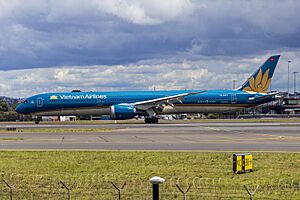
In January 2011, the airline announced plans to offer its shares to the public. This process was delayed several times but eventually happened. The money raised would help Vietnam Airlines expand its fleet and flight network.
In February 2012, Vietnam Airlines increased its ownership in the low-cost airline Jetstar Pacific Airlines to 70%. This helped Jetstar Pacific get new planes. In late April 2012, Vietnam Airlines also arranged to lease eight Boeing 787-9s.
In July 2014, a new route from Hanoi to Tokyo-Haneda was added. Vietnam Airlines received its first Airbus A350-900 in late June 2015. This made it the second airline in the world to operate this type of plane. In August 2015, the airline's first Boeing 787-9 joined the fleet.
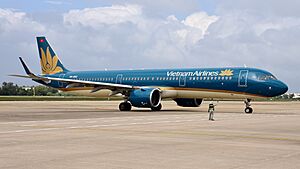
In November 2018, the airline received its first Airbus A321neo. In April 2020, Vietnam Airlines took full ownership of Jetstar Pacific, which was then renamed Pacific Airlines. In November 2021, Vietnam Airlines started its first direct flights to the United States, from Ho Chi Minh City to San Francisco.
How Vietnam Airlines Works
|
Native name
|
Tổng Công Ty Hàng Không Việt Nam - CTCP
(lit. Vietnam Airlines Corporation - JSC) |
|---|---|
| Government-owned Joint-stock company | |
| Traded as | HOSE: HVN |
| Industry | Airline industry |
| Founded | 1996 (with roots tracing back to 1954) |
| Headquarters | Long Bien District, Hanoi, Vietnam |
|
Area served
|
Asia, Europe, North America and Oceania |
|
Key people
|
|
| Services | Aircraft maintenance and overhaul, catering, cargo and passenger transport |
| Revenue | |
| Owner | Government of Vietnam |
|
Number of employees
|
18,641 (2021) |
| Parent | Government of Vietnam (86.34%)
|
| Subsidiaries |
|
Vietnam Airlines became a Joint Stock Company in 2015. This was a big step for the airline. Its main goal is to help Vietnam's economy. This includes flying passengers and cargo, helping the government budget, and offering special flights.
The airline is managed by a team of seven people. The Prime Minister of Vietnam chooses these managers. As of September 2022, Dang Ngoc Hoa is the chairman, and Le Hong Ha is the president and CEO. In December 2019, the whole Vietnam Airlines Group had over 21,000 employees. Vietnam Airlines itself employed over 6,400 people. The main office is in the Long Bien District of Hanoi.
When Vietnam Airlines took full ownership of Pacific Airlines, the company started using the name Vietnam Airlines Group. This group includes Vietnam Airlines, Pacific Airlines, and Vietnam Air Services Company.
Training Pilots
In 2009, Vietnam Airlines, Airbus, and ESMA Aviation Academy created a company called Bay Viet Flight Training. This company trains pilots in Vietnam. They hoped to train up to 100 new pilots each year. Vietnam Airlines also sends some of its pilot trainees to CAE Global Academy Phoenix in Arizona, United States.
Financial Success
Vietnam Airlines has generally been successful. Even during the 1997 Asian financial crisis, the airline still made a profit. In 1996, it carried 2.5 million passengers. By 2002, this number grew to over 4 million passengers. The airline also transported a lot of cargo, making a good profit that year.
Even with the severe acute respiratory syndrome (SARS) outbreak in 2003, the airline still made a profit. In 2006, it carried 6.8 million passengers. By 2007, it carried over 9 million passengers and earned a gross profit of US$23 million. In 2012, the company's total earnings were US$2.4 billion.
In February 2012, Vietnam Airlines carried about 40% of all international passengers flying to and from Vietnam. It also controlled 77% of the domestic flight market. By December 2012, Vietnam Airlines still controlled almost 70% of the domestic market.
Other Companies in the Group

The Vietnam Airlines Group includes many other companies. By 2015, the company planned to reduce its ownership in some of these businesses.
- Vietnam Air Service Company: This is a subsidiary that provides passenger transport. Vietnam Airlines owns 100% of it.
- Vietnam Airlines Engineering Company: This subsidiary handles aircraft maintenance. Vietnam Airlines owns 100% of it.
- Vietnam Airlines Caterers: This subsidiary provides catering services. Vietnam Airlines owns 100% of it.
- NoiBai Catering Services: This is another subsidiary for catering. Vietnam Airlines owns 100% of it.
- Pacific Airlines: This subsidiary provides passenger transport. Vietnam Airlines owns 98% of it.
- Vietnam Aircraft Leasing Company: This is a joint venture for aircraft leasing. Vietnam Airlines owns 20% of it.
Maintaining and Building Aircraft
Vietnam Airlines is becoming more involved in fixing, overhauling, and even making aircraft parts. The Vietnam Airlines Engineering Company (VAECO) handles maintenance work. VAECO was created in 2009 by combining two aircraft maintenance bases. VAECO fixes planes for Vietnam Airlines and other airlines too. As of 2013, VAECO could perform many types of maintenance checks on different aircraft.
Vietnam Airlines also works with other airlines and maintenance companies for repairs. While there are no aircraft production factories in Vietnam yet, Vietnam Airlines plans to build a maintenance factory with companies like Rolls-Royce. They also have an agreement with EADS to possibly assemble and make plane parts in the future.
Where Vietnam Airlines Flies
Vietnam Airlines has flights across Asia, North America, Europe, and Oceania. It operates about 300 flights every day. The airline flies to 22 cities within Vietnam and 37 international destinations. It also has special agreements with other airlines, called codeshare agreements, for even more routes, including some to North America.
Special Tết Flights
Vietnam Airlines always adds more flights during the annual Tết celebration. Tết is Vietnam's most important holiday, usually in late January or mid-February. Many extra flights are scheduled so people can travel home to their families. In 2010, the airline increased its seats by 45% to 120% on some domestic routes. In 2011, it added over 100,000 extra seats, with about 63,000 of those between Hanoi and Ho Chi Minh City. In 2013, the airline added 174,000 extra seats during this busy time.
Airline Partnerships
Vietnam Airlines joined the SkyTeam airline alliance on June 10, 2010. This means they work closely with other airlines in the SkyTeam group.
Partner Airlines
Vietnam Airlines works with these airlines through codeshare agreements:
- Aeroflot
- Air Europa
- Air France
- All Nippon Airways
- Bangkok Airways
- Cambodia Angkor Air
- Cathay Pacific
- China Airlines
- China Eastern Airlines
- China Southern Airlines
- Delta Air Lines
- El Al
- Etihad Airways
- Finnair
- Garuda Indonesia
- ITA Airways
- Kenya Airways
- KLM
- Korean Air
- Lao Airlines
- Middle East Airlines
- Pacific Airlines
- Philippine Airlines
- Qantas
- Saudia
- Scandinavian Airlines
- SNCF (railway)
- TAROM
- Turkish Airlines
- VASCO (a company it owns)
- Virgin Atlantic
- XiamenAir
Vietnam Airlines Fleet
Current Aircraft
As of August 2024, Vietnam Airlines uses these planes:
| Aircraft | In service | Orders | Passenger | Notes | |||
|---|---|---|---|---|---|---|---|
| C | W | Y | Total | ||||
| Airbus A320neo | 3 | 1 | 4 | — | 180 | 184 | Delivery started in July 2024. |
| Airbus A321-200 | 42 | — | 16 | — | 162 | 178 | One plane has the SkyTeam livery.
Older planes will be retired. |
| 168 | 184 | ||||||
| 8 | 195 | 203 | |||||
| Airbus A321neo | 20 | — | 8 | — | 195 | 203 | |
| Airbus A350-900 | 14 | — | 29 | 45 | 231 | 305 | |
| 36 | 240 | 305 | |||||
| Boeing 787-9 | 11 | — | 28 | 35 | 211 | 274 | |
| — | 283 | 311 | |||||
| Boeing 787-10 | 6 | 2 | 24 | — | 343 | 367 | |
| Vietnam Airlines Cargo fleet | |||||||
| Airbus A321-200/P2F | — | 2 | Cargo | ||||
| Total | 96 | 6 | |||||
Planes Used in the Past


Since it started in 1956, Vietnam Airlines has used many different types of planes. These included planes from the Soviet Union, America, and Europe. Now, the airline only uses planes made by Boeing and Airbus.
Here are some of the planes Vietnam Airlines has used over the years:
- Aero Ae-45
- Airbus A300-600
- Airbus A300B4
- Airbus A310-200
- Airbus A310-300
- Airbus A320-200
- Airbus A321-100
- Airbus A330-200
- Airbus A330-300
- Antonov An-2
- Antonov An-24
- Antonov An-30
- ATR 72-200
- ATR 72-500
- Boeing 707-320
- Boeing 707-320B
- Boeing 707-320C
- Boeing 727-100
- Boeing 727-200
- Boeing 737-300
- Boeing 767-200ER
- Boeing 767-300ER
- Boeing 777-200ER
- Douglas DC-3
- Douglas DC-4
- Douglas DC-6
- Fokker 70
- Ilyushin Il-14G
- Ilyushin Il-18
- Lisunov Li-2
- Mil Mi-4
- Tupolev Tu-134A
- Tupolev Tu-134B
- Yakovlev Yak-40
Services on Board
Entertainment
On flights using Airbus A350 and Boeing 787 planes, Vietnam Airlines offers entertainment on personal screens. On flights with Airbus A321neo planes, you can watch entertainment on your own devices. You can choose from movies, games, TV shows, audiobooks, and music. Vietnam Airlines also has two magazines, Heritage and Heritage Fashion, for reading.
Cabin Classes
- Business Class
Business class is the highest class offered by Vietnam Airlines. It has many more features than economy class. On Airbus A321 planes, the seats recline and are arranged in a 2-2 layout. These seats offer plenty of legroom and a footrest. On Boeing 787s and Airbus A350s, the seats can lie completely flat. These planes also have a 15.4-inch entertainment screen. Meals are served on flights longer than two hours.
- Premium Economy
Vietnam Airlines' premium economy class has wider seats and more legroom than economy class. This class is only available on flights using Boeing 787 Dreamliner or Airbus A350 planes. Hot meals are served, with a choice of Vietnamese and international dishes. You also get a personal care bag with useful items.
- Economy Class
Economy class is available on all Vietnam Airlines flights. The seats are about 32 inches wide and have 31-32 inches of legroom. They can recline a bit. Snacks are offered on flights over 90 minutes, and hot meals are served on flights longer than two hours.
Lotusmiles Program
Lotusmiles is the airline's program for frequent flyers. It has five levels: Silver, Titanium, Gold, Platinum, and Million Miler, each with different benefits. Joining the program is free. Members can earn miles by flying with Vietnam Airlines Group, SkyTeam airlines, or partner airlines. They can also earn miles by using co-branded credit cards or services from partners like Booking.com. You can use your earned miles to buy tickets, items from Lotusmall, or vouchers for other services.
Safety Record
Vietnam Airlines has a good safety record. Since 1951, it has had a few incidents, but safety has always been a top priority. The airline works hard to ensure all flights are safe for passengers.
See also
 In Spanish: Vietnam Airlines para niños
In Spanish: Vietnam Airlines para niños





